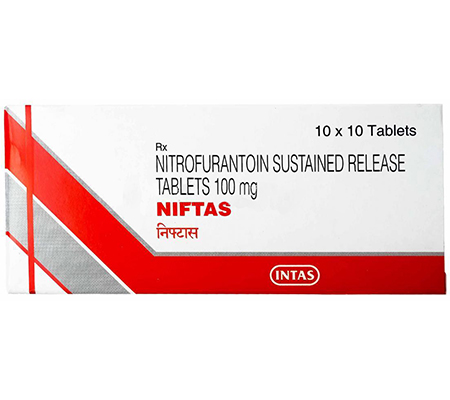Niftas
- Ingredient:Nitrofurantoin
- Manufacturer:Intas
- Brand Name:Macrobid
Niftas 50 mg
| Qty: | Total | Item price | Saving | |
|---|---|---|---|---|
| 10 pills | $5.00 | $0.50 | - | |
| 20 pills | $9.00 | $0.45 | $1.00 | |
| 40 pills | $17.00 | $0.42 | $3.00 | |
| 60 pills | $24.00 | $0.40 | $6.00 | |
| 80 pills | $30.00 | $0.38 | $10.00 | |
| 100 pills | $35.00 | $0.35 | $15.00 |
Niftas 100 mg
| Qty: | Total | Item price | Saving | |
|---|---|---|---|---|
| 10 pills | $9.00 | $0.90 | - | |
| 20 pills | $16.20 | $0.81 | $1.80 | |
| 40 pills | $30.60 | $0.76 | $5.40 | |
| 60 pills | $43.20 | $0.72 | $10.80 | |
| 80 pills | $54.00 | $0.68 | $18.00 | |
| 100 pills | $63.00 | $0.63 | $27.00 |
A bacteriostatic or bactericidal agent depending on the concentration and susceptibility of the infecting organism. Nitrofurantoin is active against some gram positive organisms such as S. aureus, S. epidermidis, S. saprophyticus, Enterococcus faecalis, S. agalactiae, group D streptococci, viridians streptococci and Corynebacterium. Its spectrum of activity against gram negative organisms includes E. coli, Enterobacter, Neisseria, Salmonella and Shigella. It may be used as an alternative to trimethoprim/sulfamethoxazole for treating urinary tract infections though it may be less effective at eradicating vaginal bacteria. May also be used in females as prophylaxis against recurrent cystitis related to coitus. Nitrofurantoin is highly stable to the development of bacterial resistance, a property thought to be due to its multiplicity of mechanisms of action.
Niftas may be used as an alternative in the treatment of urinary tract infections. May be used by females pericoitally for prophylaxis against recurrent cystitis related to coitus.
Niftas exhibits bacteriostatic or bactericidal effects by inhibiting the synthesis of DNA, RNA, protein and cell wall synthesis.
Niftas is activated by bacterial flavoproteins (nitrofuran reductase) to active reduced reactive intermediates that are thought to modulate and damage ribosomal proteins or other macromolecules, especially DNA, causing inhibition of DNA, RNA, protein, and cell wall synthesis. The overall effect is inhibition of bacterial growth or cell death.
Niftas is readily absorbed in GI tract primarily in small intestine. Enhanced by food or delayed gastric emptying via enhanced dissolution rate of the drug.
Acute toxicity may cause vomiting. Adverse effects include nausea and urine discolouration. Rare hepatotoxic and hypersensitivity reactions have occurred. Hemolytic anemia is a risk in patients with G6PD deficiency. Ascending polyneuropathy may occur with prolonged therapy or in patients with low creatinine clearance.
No review yet
No questions yet

